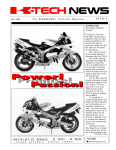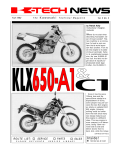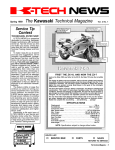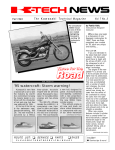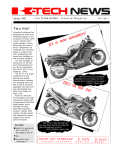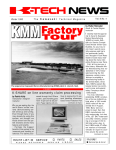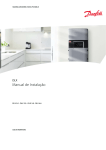Download K-Tech News Vol.2 No.4
Transcript
Winter The Kawasaki Technical Magazine tons for spreading the braking force over a larger area of the disc and reducing abnormal pad wear. At the rear is a powerful single disc brake; both front and rear discs are protected by durable, colored plastic covers. Seating height is lowered by 30mm which in turn helps to lower the center of gravity for sure-footed handling and control. Other features include aesthetically appealing frame-mounted instrumentation which includes speedometer, tachometer and temperature gauge. New semi-knobby TRIAL MAX tires provide a smooth ride on highway surfaces with longer wear and reduced road noise. The dual-purpose Tengai offers. by Tim Bean, Program Developer NTRODUCING THE KL650B TENGAI, Kawasaki’s latest addition to the dual-purpose family of motorcycling. This bike combines proven engine technology from the KL650A with sleek, frame-mounted half fairing, flush-mount headlight, aerodynamically efficient front fender and Ninja-style turn signals. The latest technological features make the Kawasaki Tengai the ultimate in dual-purpose adventures. Its air-adjustable front fork offers 220mm of road-absorbing travel with 4mm-thick inner tube wall thickness for less deflection and a confidence-inspiring ride. Rock steady Uni-Trak suspension design with five-way preload and four-way rebound damping helps keep the rear end planted firmly on all surfaces. Bringing the Tengai down to speed quickly and smoothly are Balanced Actuation Calipers (BAC) with two different sized pis- I ROUTE LIST: o SERVICE o PARTS Vol. 2 No. 4 Freedom To Roam! n INSIDE: Customer Service, Tips Galore . . . and More! o SALES RETURN TO SERVICE GUEST SPOT Meet The Consumer Services Department T HERE HAVE BEEN some personnel changes made in the Consumer Services Department recently, and now seems like a good opportunity to introduce the members of the group. Mary Sola, Supervisor, has been with KMC as a Consumer Analyst for almost 10 years. Prior to coming to Kawasaki, Mary worked as a social worker. She has a B.A. in English from UCLA and is currently working on a Master’s in Business Administration. Consumer Services Assistant Jan Raymond has also been with KMC over nine years, six of them in Consumer Services. Jan worked as a receptionist at the old Garry Street building and then for R&D before joining the Consumer Services staff. Jan has had previous customer service experience in the retail automotive field. Donna Hood, Consumer Analyst, has been with the department for over two years, having started her Kawasaki career as a temporary summer clerical worker. Donna has had extensive public relations experience, working for a variety of non-profit organizations all over the country. She graduated from the University of Kentucky with a degree in English and has recently earned a B.A. in Business from the University of San Francisco. Our newest Consumer Analyst, Sharon Reynolds, came to KMC in early November after working in the customer service department for a computer printer manufacturer for eight years. Sharon graduated from Butler University in Indiana with a Bachelor’s Degree in English and has taken classes towards a Master’s degree. We look forward to providing the high quality customer service you and your customers have come to depend upon. o KMC’s Consumer Services department: (FOREGROUND) Jan Raymond; (STANDING, L TO R) Donna Hood, Mary Sola and Sharon Reynolds. The Police Motorcycle Support Program: A Special Program For A Special Vehicle by Bill Zito, National Police Motorcycle Coordinator A T ONE TIME OR ANOTHER, as Kawasaki dealers servicing police motorcycles, you have had questions, comments and/or complaints about the Kawasaki police motorcycle. Sometimes these encounters can be less than friendly, and you might have found yourself wishing there was someone at Kawasaki Motors Corp., U.S.A., to whom you could go for assistance. Well, there is: the Kawasaki Police Motorcycle Coordinator. As the Police Motorcycle Coordinator, I 2 l K-Tech News work with and for Kawasaki dealers and law enforcement agencies all over the United States. In the months ahead, articles pertaining to the police motorcycles and the police motorcycle program will begin appearing in K-Tech News. In the meantime, if you or your local law enforcement agency have questions about the police motorcycle or its support program, please feel free to contact me at (714) 770-0400 ext. 2576, Monday through Friday, 8:30 a.m. to 5:00 p.m. (Pacific time). I look forward to assisting you with your police motorcycle needs. o Bill Zito, Police Motorcycle Coordinator. COMMUNICATIONS Service Manual Supplement System by Ray St. John, Senior Technical Writer S Service Manual Supplements and Base Manuals MOTORCYLES AND ATVs MODEL KX60-B6 KX80-M2/3, N2/3 KX125-G1 KLF185-A1A/A2 EL250-B2/3/4 EX250-F2/3/4 KL250-D2 - 7 KX250-G1 KLF300-B1/2/3 KLF300-C1/2 EX500-A1/2/3/4 KX500-E1 KL600-B1 ZL600-A1/2 ZX600-C1/2/3 KL650-A1/2/3 ZL900-A1/2 ZL1OOO-A1 ZG1200-B1 - 4 ZN1300-A1 - 6 SERVICE MANUAL SUPP. 99924-1123-51 99924-1123-51 99924-1116-51 99924-1076-51 99924-1093-51 99924-1109-51 99924-1051-03 99924-1116-51 99924-1100-51 99924-1117-51 99924-1082-51 99924-1116-51 99924-1063-52 99924-1073-51 99924-1081-51 99924-1080-52 99924-1077-51 99924-1077-81 99924-1089-51 99924-1037-02 BASE MANUAL PART NO. 99924-1094-01 99924-1094-01 99924-1101-01 99924-1058-01 99924-1066-01 99924-1066-01 99924-1050-01 99924-1101-01 99924-1057-01 99924-1057-01 99924-1056-02 99924-1101-01 99924-1050-01 99924-1055-01 99924-1055-01 99924-1050-01 99924-1048-01 99924-1048-01 99924-1064-01 99924-1015-04 MODEL OF BASE MANUAL KX60-B4 KX80-M1, N1 KX125-F1 KLF185-A1 EX250-E1 EX250-E1 KL600-A1 KX250-F1 KLF300-A1 KLF300-A1 EN450-A1 KX500-D1 KL600-A1 ZX600-A1 ZX600-A1 KL600-A1 ZX900-A1 ZX900-A1 ZG1200-A1 KZ1300-A1 99924-1059-01 99963-0054-01 99963-0051-01 99924-1069-05 99924-1069-05 JS300-B1 JS440-A1 JS550-A1 JF650-A1 JF650-A1 OME MODEL KAWASAKIS need one service manual; some need two. Why is this? Well, in the beginning, there is only one service manual including all the information the technician needs to know to maintain and repair a given model motorcycle, watercraft, generator, etc. Let’s use, for discussion’s sake, an example: the KLF300-A1. This sturdy four-wheeler which had a comprehensive service manual all to itself was followed by a similar all-terrain model, the KLF300-B1. To save time and reduce costs, the factory chose to produce only a service manual supplement to cover the unique features of the B1 model. The supplement did not cover the basic information which originally appeared in the service manual for the older model: the KLF300-A1. So you need two separate books to have all the information on the KLF300-B1—the KLF300-A1 service manual, which is called the “base manual” and the KLF300-B1 service manual supplement. o PERSONAL WATERCRAFT JS300-A1/2/3/4 JS440-A8 - 14 JS550-A3 - 8 JF650-B1/2 JS650-A1/2/3/4 99924-1070-51 99924-1091-51 99924-1075-52 99924-1122-51 99924-1087-53 The Technical Magazine 3 l SHOP TALK/TECHNICAL Upside-Down Forks-Oil Level vs. Air Volume by Gregg Thompson, Tech Support Specialist I NSTRUCTIONAL DESIGNER Jerry Heil did a good job of explaining the theory behind the inverted forks featured on Kawasaki’s latest KX125, 250 and 500 models in the last issue. Now that the bikes are here, we’ve heard that some technicians are getting a little sideways when working on the new “upside-down” forks. Confusion can arise when you attempt to check or adjust the oil level and find that it’s higher than the standard spec, even if you just rebuilt the forks yourself and very carefully set the oil level at the standard spec. Can this happen? You bet it can. In fact, it’s supposed to happen. Are you confused by that fact? Read on. After rebuilding, or when changing the oil in these new forks, all the air must be purged (burped) from the fork assembly. To do this, the fork must be compressed and then filled to the top with oil. Fig. 1 NOTE: During this procedure, the spring must be removed but the nylon spring guide and cap must be installed on the fork rod. Make sure that both rebound damping adjuster rods are inside the fork rod. (The long straight tube goes in first and the short machined piece goes on top-see Figure 1.) Purge the air from the fork cylinder by pumping the fork rod up and down. Purge the air from between the inner and outer tubes by pumping the outer tube up and down. While doing Fig. 3 this, take care to keep the oil level topped off so that it stays above the two large holes near the top of the inner tube. After purging the air from the assembly, let it sit for about five minutes so that any suspended air bubbles can surface. 4 l K-Tech News With the fork compressed and the damper rod all the way down, draw the oil out to the desired level. Now the oil level in the inner tube is at the desired level; the oil between the inner and outer tubes, however, is still full to the top (Fig. 2). So, the first time the fork assembly is extended from the fully compressed position, oil will be forced from between the tubes into the inner tube through the holes at the top of it. This raises the oil level in the inner tube. If the fork is extended to the full length of its normal travel, the oil level will be raised about 30mm (Fig. 3). NOTE: Before the spring and fork cap are installed on the damper rod, it is possible to extend the fork about 200mm more than the fork normally travels. Be careful not to do this since it will force all the oil out from between the inner and outer tubes. Some oil needs to remain in there to lubricate the bushings. Because of the transfer of oil from between the Fig. 2 tubes into the inner tube, the oil level will never again measure the same as it did when you set it at assembly (see Fig. 4). If this seems like a strange or impractical way of setting the oil level, remember that setting the oil level in a fork is really a round-about way of adjusting the air volume in the fork. The above procedure will provide an accurate and consistent air volume in both forks. After the initial adjustment, the air volume in the fork can be changed by adFig. 4 ding or subtracting a precise oil volume. If you’re experimenting with air volumes (oil levels), keep accurate records of oil added or removed after the initial set up. The next time you change the oil, set the oil level the same way and then add or subtract oil again to get the air volume where you want it. o COMMUNICATIONS MICROby “Micro” Mike Jeffers, Parts Publications Specialist W HEN USING THE PARTS MICROFICHE, are you confused by the dotted lines below the part description? Do you know what these lines are used for? Next, verify that the description found in the part description line (“B”) is correct. Look for different colors or effective frame number ranges that may apply. Finally, confirm that the part number applies to the correct market area. The market areas are indicated by the abbreviations “US” for United States, “CN” for Canada and “CA” for California (example “C”). For explanations of this and other aspects of the parts ordering system, read the Parts List Introduction section on Row A of every parts microfiche. n To further simplify the ordering of painted parts, the Color Combination Parts List has been added to all 1990 parts microfiche. This list supplies the part number, description and market area of all painted parts in an organized and easy-to-use chart. In the accompanying example (see below) from the the ZX600-D1 microfiche, there are two lists of painted parts; one for each color. The lists will appear on the A row. The “O” indicates that the pat-l number is applicable for the market area. The “X” indicates that it is not applicable. A single parts catalog may include up to five model years and a model year may include more than one choice of colors or graphics. Factor in the need for information on market area (U.S. and Canada) and/or parts required to meet emission control standards (California) plus all optional equipment available, and you realize a lot of information is required. There isn’t room enough in the catalogs to have separate illustrations for each individual part, nor would the differences be readily apparent. In the Kawasaki parts catalogs, this problem of space has been solved by using a single illustration accompanied by reference numbers. The dotted line items are used to give specific information relating to the conditions noted above. So, when working with dotted lines, follow this procedure: Check to make sure the part number applies to the model year listed in the quantity column (see “A” on the illustration above). ©1990 Kawasaki Motors Corp., U.S.A. (KMC). All rights reserved. Published by Kawasaki. All suggestions become the property of KMC. Sending a service suggestion gives Kawasaki permission to publish and/or use it without further consideration. Specifications subject to change without notice. COLOR COMBINATION PARTS LIST ZX600-D1 n Please direct all inquiries on microfiche-related matters to Mike Jeffers, (714) 770-0400 ext. 2573, or fill out the Micro-K report card (P/N M99994-152). o K-TECH NEWS STAFF Publisher ....... Kawasaki Tech Services Publications Manager ........ Don Church Executive Editor . . . . . . . . . . . . . . . . Gary Herzog Editor-in-Chief ......... Gregg Thompson CONTRIBUTORS Randy Davis, Bob Ellison, Mike Jeffers, Tevis Moffett, Ken Osberg, John Porno, Steve Rice, Mary Sola, Ray St. John, Bill Zito REGIONAL EDITORS North and East . . . . . . . . . . . . . . . .. Fred DeHart Central and South . . . . . Walter Rainwater West and Corporate . . . . . . . . . . Patrick Kelly GRAPHICS AND PRODUCTION Graphic Art . . . . . . . Tim Bean, G. Thompson Copy Editor ....................... Pat Shibata Production....Nickless Communications The Technical Magazine 5 l TIPS FROM THE SPECIALISTS Mule 1000 Transmission Short Cut ONTRARY TO WHAT the service manual tells us, it is possible (even practical) to remove the transmisC sion assembly from the Mule 1000 (KAF450) without removing the engine. STEVE RICE ILLUSTRATION Limited-Slip Diff. Oils for 4x4s T HE KLF300 BAYOU 4x4 Owner’s Manual calls for SAE 140 LSD GL-5 oil in the front differential. It has come to our attention that this exact oil can be hard to find. That’s the bad news; the good news is that you can substitute other “limited-slip differential” (LSD) gear oils for the one listed in the manual without creating problems. LSD oils are available at almost any automotive supply store. The most common viscosity is 80W-90, but many manufacturers, such as Valvoline, Pennzoil, and Quaker State, offer an 85W-140 LSD oil. The important thing is to make sure the oil you choose is GL-5 rated and formulated for limited-slip differentials. It will say so on the label. In extreme conditions, such as high heat or very hard use, you should probably use either a straight 140W or an 85W-140 oil. In the event that one of these LSD oils is not available in your area, several manufacturers offer an LSD additive that can be mixed with any GL-5 oil to make it work in limited-slip differentials (non-LSD 85W140 GL-5 oil is easy to find). LSD additive is available from most auto supply stores, Kendall Oil suppliers and - Kenny Osberg even your local Chevrolet dealer. 6 l K-Tech News There really are no tricks to this time-saving tip. Remove both torque converters and covers. Pry the axle shafts out of the differential, disconnect the swingarms from the chassis and move the assemblies out of the way. Now, unbolt the transmission case from the engine case and pull out the transmission assembly. A few of the bolts connecting the transmission to the engine are a little hard to get out with everything still in the chassis, but you can do it. By using this method, you’ll not only save time, but also the aggravation of dealing with the cooling and electrical systems. The same basic idea holds true for engine removal. The difference is that when removing the engine, you must disconnect all the cooling and electrics. You can leave the rear axles in place which has the added benefit of leaving you free to roll the chassis around with the engine out. When reconnecting the transmission and engine, be careful with the O-rings and gaskets. - Randy Davis 100cc Kits AWASAKI has developed 100cc kits for both 1990 KX80 models. A new cylinder and piston increase K the bore to 52.5mm for an actual final displacement of 99cc and increased compression ratio of 8.9:1. These kits will make the KX80 models even more competitive than they already are in 100cc class racing. Horsepower and torque are increased throughout the entire rpm range. The kits also include a 48-tooth rear sprocket for the KX80-L3 (49-tooth is standard) and 52tooth rear sprocket for the KX80-N3 (54-tooth is standard) to take full advantage of the power increase. The kits may be purchased under P/N 99995-1031 (KX80-L3) or 99995-1032 (KX80-N3). For more information, refer to Racing Support Bulletin RS89-09. - Mike Jeffers KSF250 Kickstarter Gear Breakage I F SOMEONE BRINGS A KSF250 Mojave into your shop with broken kickstarter gears, be sure to take a compression test. Since this engine has an automatic compression release (KACR), the kickstarter gears are not designed to handle a lot of compression during starting. Cranking pressures should not be higher than about 120psi (the book spec is 115psi). If you run across one with broken starter gears and high cranking pressures, check the automatic compression release mechanism on the camshaft. If it seems to be operating properly but still has high compression, call the Hot Line for more information. -John Porno Tires: Why OEM? Y OU MAY HAVE WONDERED why Kawasaki recommends using only OEM (Original Equipment from Manufacturer) replacement tires for its products. The reason is that tires have a tremendous overall affect on the handling characteristics of a motorcycle and different tires can affect different areas of performance. What areas? Both low- and highspeed handling, traction, responsiveness to road conditions, straight-line stability vs. cornering response, and wear. Aftermarket tires may improve one performance area only to reduce performance in another; a high-traction tire may have less high-speed stability, for instance. Kawasaki spends hundreds of hours testing before deciding on an OEM tire, but this testing is done with OEM candidate tires, not aftermarket products. Testing is expensive and time consuming-the same tests must be done with each tire for each model since a tire’s characteristics can vary from one model to another-and Kawasaki cannot do it for aftermarket tires. When recommending replacement tires, offer advice based on the collective experience of your personnel. Always let the customer decide, but remember, you can’t go wrong recommending OEM tires. - Gregg Thompson Mule 1000 Trans. Improvements U NDER EXTREME USAGE, some KAF450-B1 Mule 1000’s have suffered major transmission failures. Kawasaki believes this is the result of repeatedly shifting the transmission into gear when the engine is above a normal idle speed, such as when the starting enrichener (choke) is on. Though this is not what we consider “normal usage” it is fairly common and the resulting damage is considerable. For this reason, Kawasaki has modified some of the transmission parts to improve durability. For a limited time, all these modified parts will be available in kit form. If a KAF450-B1 comes into your shop with a damaged transmission, call the Hot Line for information about the kit. The kit (P/N 99995-1193) includes some parts which have not been modified. - Gregg Thompson The Technical Magazine 7 l TIPS FROM THE SPECIALISTS JET SKI ® Clutch Slipping? F COURSE THERE IS NO CLUTCH in a JS650 JET SKI watercraft, but every now and then a O dealer must diagnose what really does seem to be a slip® ping clutch. The engine runs fine and revs up in the water when the throttle is opened but “the boat won’t go!” says the customer. The problem is most noticeable when accelerating from a dead stop or coming out of a turn. The “slipping clutch” sensation is caused by either cavitation or an improper seal between the pump housing and the hull. Cavitation is the formation of gas bubbles (a partial vacuum) in the water as it passes through the pump. Some cavitation occurs in all of our jet pumps during normal use. You’ve seen the effects of cavitation in the pitting that occurs at the base of the blades on stock aluminum impellers. Excessive cavitation can be the result of damage to the leading edge of the impeller blades or pump guide vanes, a rough transition between the hull and pump housing (cobby silicone job), or a foreign object (such as seaweed) in the intake grate. A poor seal between the pump housing and the hull will result in air being drawn into the pump from around the pump housing. This can sometimes be hard to spot. The silicone will usually remain in place attached to the pump housing even though it has been separated from the hull. This problem is much more noticeable in the larger, heavier vehicles, such as the Tandem Sport (TS) and the JET MATE™. Usually it results from insufficient amounts of silicone between the pump housing and the hull. Simply adding more silicone to the outside, along the leading edge of the pump housing, will probably not solve the problem; most likely you’ll have to remove the pump assembly and reseal the top and sides to the hull. If you suspect the pump might not be sealed properly to the hull, you can quickly and easily check it out. Set the boat on its side, if possible, and remove the intake grate. Then spray a soapy water solution all around the leading edge of the pump housing and blow high pressure air in the back between the housing and the hull. If it’s not sealed properly, you will soon see bubbles at the leading edge of the pump. - Gregg Thompson Don’t Drill That Hull. . . Yet! N THE PAST, all JS300B, late model JS440A, and JET SKI watercraft hulls came with a reinforcIingJS550A plate inside the lower rear corners of the hull. The ® plate was there to hold the rivets that fasten the stabilizers to the JS550 hull. The plate has been on all these boats for several years and many technicians have put 550 stabilizers on 300s and 440s assuming that the plate was in there. However, for part of the JS440-A14 production run, the plate was not included in the hull. JS440-A14s from hull number KAW00395H990 through KAW01005K990 do not have the plates and should not be drilled to accept the JS550 stabilizer; without the reinforcing plate, the rivets will not hold. 8 l K-Tech News Please keep this information where you can find it if you ever take in a JS440-A14 to which you’re considering adding the stabilizers. - Gregg Thompson Don’t Let Your Compression Gauge Fool You W HEN CHECKING compression on some of Kawasaki’s liquidcooled, four-valve engines, note that some aftermarket compression gauge adapters (such as those made by Snap-On) may give incorrect (i.e. low) readings. This is especially true when the smaller 10mm and 12mm spark plugs are used. Why? Well, the space around the spark plug hole is very small on these engines; some aftermarket gauge adapters don’t fit properly and can leak. Also, many of our late model engines have over 200psi cranking pressure and some aftermarket adapters simply don’t seal tightly enough at the cylinder head to prevent leakage at those high pressures. The type of gasket and method of tightening the adapter will have an affect on this. Sometimes an aftermarket adapter can be modified to work better. If you already have a complete (or nearly complete) compression tester set, you may want to take this route. But, if you don’t already have a complete compression gauge set, you should consider buying the genuine Kawasaki gauge and adapters. They are more expensive, but they’re especially designed for our engines and they work-no hassles. Here are the part numbers for the Kawasaki compression gauge and adapters, 10mm and 12mm long and 12mm and 14mm short: - Gregg Thompson 57001-221 Compression Gauge (gauge only) HE FIRST TIME an engine is started after an oil and filter change, there will be a delay before oil pressure comes up while the oil lines and filter fill up with oil. Most of this delay is caused by an empty oil filter. You can significantly shorten this time by filling the new oil filter with oil before installing it. Just set the filter on the bench open end up and pour oil into the center (threaded) hole. It will take a minute for the oil to soak into the filter element and you‘ll have to top it off a couple of times. A little oil may dribble out while you are spinning the filter onto the engine, but the reduction in engine wear is well worth the minor clean up required. - Gregg Thompson 57001-1159 14mm Adapter, short 57001-1179 10mm Adapter, long 57001-1183 12mm Adapter, short EX500 Shift Return Spring Spin-On Oil Filters T 57001-1018 12mm Adapter, long H AVE YOU EVER had an EX500 customer come into your shop complaining that his transmission would no longer shift and discovered that the shift shaft return spring had popped off the back of the shift pawl? In the past, when the Hot Line technicians received calls about this, we would suggest the dealer install a 1mm spacer on the shift shaft between the locating circlip and the transmission cover. This reduced the end play in the shaft and proved to be an effective fix. Recently, however, Kawasaki Quality Assurance people have identified the problem as the spring itself. In current production, a different spring is being used; the old spring is no longer available and the new part number substitutes automatically. So, if you run into this problem on a 1989 or earlier EX500, just order the shift shaft return spring shown on the microfiche and you will get the new (improved) part. - Gregg Thompson The Technical Magazine 9 l TIPS FROM THE SPECIALISTS New Math: Calculating Lobe Centers H AVE YOU EVER had trouble remembering the formula for computing camshaft lobe centers? If so, here’s a formula that might be easier for you to remember. To show you how it works, we’ll use the cam specs listed in the service manual for the ZX-7 intake cam. Why Lobe Centers? H IGH PERFORMANCE camshaft manufacturers supply “checking specifications” with their cams. Checking specs are valve opening and closing times at a certain amount of valve lift. The cam manufacturer specifies the amount of lift (.050" and 1.0mm are common checking heights) and what the cam timing should be at that amount of valve lift. The reason for doing this is that when the valve first begins to open, the cam ramp angle is very shallow and the valve movement is very slight relative to crank movement. It is impossible to tell within a degree or two when the valve first begins to move. Farther up the cam ramp, the valve is being opened much more rapidly and it is easy to detect valve movement at very small amounts of crankshaft movement. Thus, accuracy that is impossible to obtain at valve opening is easy to achieve at 1.0mm of valve lift. In some cases, the manufacturer’s checking specs may not be known. In the case of Kawasaki OEM cams, checking specs are not provided by the manufacturer. To accurately set the cam timing, you must use an arbitrary checking height (say 1.0mm) and measure the opening and closing numbers at that lift. From those specs, you compute lobe center and compare it to the lobe center computed from the service manual specs. Once you get used to “thinking” lobe centers, you’ll begin to use LIFT, DURATION and LOBE CENTER as indicators of what performance characteristics a cam will provide. Lobe center is not only just as important as lift and duration, it’s the only one of those specs a tech- Gregg Thompson nician can adjust. Open: 35 degrees BTDC (Before Top Dead Center) Close: 65 degrees ABDC (After Bottom Dead Center) To get the lobe center, subtract the smaller number from the larger number: 65 - 35 = 30 Add 180 to that number: 30 + 180 = 210 A Tip From Consumer Services Divide that number by 2: 210 / 2=105 The lobe center for the ZX-7 intake camshaft is at 105 degrees (After Top Dead Center). - Steve Rice 10 l K-Tech News I F YOUR CUSTOMERS need to contact Consumer Services regarding a Kawasaki product. be sure and tell them we will need the unit’s identification number: Most of the records at KMC are accessed by ID number, and when we have a VIN or HIN, we can easily and accurately check on warranty status, repair history, or previous contacts to either the Hot Line or Consumer Services. Generally this information allows us to quickly answer a customer’s questions and helps us to resolve a complaint faster and more - Mary Sola efficiently. Tandem Sport: Water From The Bulkhead A FEW JF650-B1 TANDEM SPORTS have had a mysterious problem with water leaking into the engine compartment through various holes in the bulkhead. Some dealers have mistakenly tried to fix this by sealing the holes in the bulkhead where the water was coming through. Problem is, there isn’t supposed to be any water behind the bulkhead in the first place. The real source of the water is not the bulkhead holes but, instead, one or more of the tubes that connect the pump area of the hull to the bulkhead. These include the cooling water tube, bilge pump tube, steering cable tube and driveshaft tube. If you have a TS with this taking-on-water problem, check all four of these tubes for leakage. The easiest way to do this is to fill the engine compartment with water and watch it leak out the back. If water leaks out from aroundany of the tubes, seal those tubes to the hull in the back where the water is running out. Use the Kawasaki Hull Repair Kit or some other seagoing epoxy putty. Do not use silicone sealant; you want this repair to be permanent. If water leaks out from inside the driveshaft tube, you must seal the front end of the tube to the bulkhead. To do this, you have to remove the driveshaft and bear- REGIONAL NEWS South & Central CONTINUED FROM PAGE 12 Are your technicians in uniform? Is the floor clean? Are the walls clean? Is the shop well lighted? Are the signs of professional quality? Do you have your labor rate posted? If you answer “No” to one or more of these questions, you need to improve the “packaging” of your product to make it more desirable to your customers. Once the service department is ready to make money, it needs to be promoted just like your other profit centers. The service department already has a list of potential customers from your sales records. The bottom line is that you and only you determine what your service business is and what it will be like in the future. Walter Rainwater, 6110 Boat Rock Blvd. S. W., Atlanta, GA 30378, (404) 349-2000. ing holder. Fill any gap between the end of the driveshaft tube and the bulkhead with epoxy putty. After performing this repair, be sure to thoroughly drain the water from behind the bulkhead by tipping the back end of the boat up and letting it set for a while. You may need to drill a small drain hole near the bottom edge of the bulkhead. - Gregg Thompson Seal with epoxy putty 1990 KX Model Standard Carburetor Jetting O OPS! IT SEEMS there are some differences regarding standard carburetor jetting between the microfiche, owner's manuals and the 1990 KX model bikes themselves. Where there are differences between the written materials and a bike, the bike is probably right. But, just in case, here are the correct standard jetting specs for the 1990 KX125, 250, and 500: Air Screw Opening Throttle Valve Cutaway Pilot Jet Jet Needle Jet Needle Clip Position Main Jet KX125-H1 KX250-H1 1½ 6 52 1½ 7 N84C 3 155 60 N85C 3 160 KX500-E2 1½ 7 60 N82M 3 168 -Gregg Thompson Fuel Injection Tip W HEN DIAGNOSING a rich-running condition on any of our fuel injected bikes, especially one that’s been stored for a long time, don’t forget the fuel return check valve in the fuel tank. First, check the fuel level in the filter. If it is over 1/3 full, replace it. If fuel level is still high, check fuel pressure. If the fuel pressure is high (over 36psi), check the fuel return check valve in the fuel tank. If it is corroded and stuck or blocked, a rich condition will result. - Bob Ellison The Technical Magazine l 11 REGIONAL NEWS What? How? by Fred DeHart n A TRULY great technician is not just a person who can disassemble and assemble a piece equipment. of The technician must also understand what each part is meant to do, why it was designed to do it, and how it gets the job done. This type of understanding assures quick diagnosis of problems and proper assembly of components. Kawasaki Technical Training classes provide you with the what, how, and why necessary to understand our products. This understanding will make your job easier and increase your efficiency. As you can see from reading this issue of K-Tech News, our training classes have been restructured and new classes are being offered. Make sure you read the technical training schedule bulletins as they arrive at your dealership. Sign up early. I look forward to meeting with you as we learn together. I Fred DeHart, 201 Circle Drive N., # 1 0 7 , P i s c a t a w a y , N J 08854, (201) 469-1221. S A PROfit center, the service department buys labor and parts at wholesale and markets them at retail. The degree of success in marketing service determines the amount of profit. 12 l K-Tech News Classes Held In Piscataway, N. J. MARCH 7-9 Fuel Systems Service Department Operations 12 High Performance Engines 13 14-15 ATV Service Parts Department Operations 22 Generator 23 27-29 JET SKI® Watercraft North Region Training Schedule Classes Held In Grand Rapids, Mich. MARCH ATV Service Central Region Training Schedule Classes Held In Fort Worth, Tex. MARCH West Region as practical experience from having been an owner of a Kawasaki dealership. More recently, I was an instructor for a motorcycle mechanics school, where I gained teaching experience in all aspects of motorcycle operation and repair. I look forward to meeting all of you when you attend classes at the West Region training center. Hope to see you soon! Patrick Kelly, 9950 Jeronimo Road, Irvine, CA 92718, (714) 770-0400. 26-27 Team Green Race Preparation 28-30 JET SKI® Watercraft West Region Training Schedule Classes Held In Irvine, Calif. MARCH 1 8 12-14 15 19 20-21 22 26-28 29 Voyager Familiarization Generator Police Motorcycle Maintenance Shaft Drive Service Department Operations Team Green Race Preparation Product Update JET SKI® Watercraft High Performance Engines South Region Training Schedule The Service Department: Make It Attractive by Walter Rainwater n South & Central A East Region Training Schedule 1-2 Greetings! by Patrick Kelly n ‘D LIKE TO take this opportunity to introduce myself. My name is Patrick Kelly, and I’m very pleased to be the new training instructor for the West Region. I have been an enthusiast of, and have enjoyed working with, Kawasaki products for many years. My background consists of extensive formal training in the field of motorcycle mechanics, as well North & East Regions The first step in marketing a product is to make it attractive and desirable to the consumer. Most products are placed in attractive packages covered with statements proclaiming their virtues. The physical appearance of the service department is the package for the service product. CONTlNUED ON PAGE 11 Classes Held In Atlanta, Ga. MARCH JET SKI® Watercraft JET SKI® Watercraft High Performance 12-15 Engines High Performance Engines 19 20-21 Team Green Race Preparation Generator 22 5-7 8












